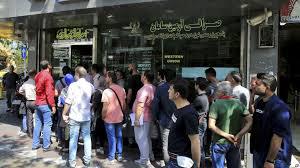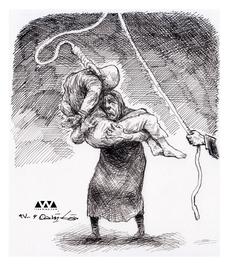The lines outside currency exchange offices in Tehran continue to be long, as the black market value of the Iranian rial (IRR) sinks to a new low. Out on the streets, groups of men hold out greenbacks to sell to interested passersby. And all the while, the government seems to be helpless as people’s despair continues and the economic turmoil deepens.
More than once over the last few months, I have started out my dispatches with the phrase: “the Iranian rial is in decline.” And that decline has not stopped. On Tehran’s currency black market, the US dollar reached a new historic record on Tuesday, September 4, with an exchange rate of 150,000 rials to the dollar. Ordinary citizens are in a state of panic, with many trying to exchange their rials for something else — in some cases, anything else. When SAIPA, an Iranian car manufacturer, launched an online pre-sale of 50,000 of its Pride models, six million people rushed to the website, buying 50,000 of the infamously hazardous vehicle in less than one minute.
The government still insists on using brutal force to combat events in the market — and yet it has lost control over it, and Iranians know it. “Every day I see police officers, and dealers who buy and sell foreign notes,” Reza, a 40-year-old shopkeeper who works close to Tehran’s Istanbul Square neighborhood, the traditional center for currency exchange shops and currency dealers, told me — he himself walking on the street grasping dollars and euros in his fists. He has witnessed arrests — and how quickly someone new replaces the arrested person. Several of the street dealers stop by his store to share gossip. “Rumors have it that these are all the government’s plans. They want to let the rial sink to 200,000 rials per US dollar, then stabilize it around 100,000.” Reza is not alone in believing this. Many people who claim to be in touch with people in the know, like a major government official, also keep repeating this story.
The ultra-conservative newspaper Kayhan Daily, which is highly critical of President Rouhani’s administration, ran the following headline on Thursday, September 6: “Wait for 20,000 Tomans per Dollar!” Its editorial that day attacked all branches of the regime: executive, judiciary, and the legislative. “When the heads of branches, who have every ounce of power possible to deal with the economic issue, do not do anything, we should expect to see 20,000 tomans for a dollar pretty soon,” it said.
This is not a prophecy, it’s a warning. Abdullah, a 55-year-old dentist, told me: “No one is doing anything and people are getting worried.” The biggest concern is that President Rouhani’s administration seems to be oblivious. The government authorities and officials list what they intend to do, but the public confidence in the political establishment is at an all-time low. Majid, a 26-year-old reporter, says, “People are worried, angry and tired. Nothing seems to work”.
No Unified Currency Market
On paper, it would appear as though the Iranian government has engineered the Iranian market perfectly. It has allocated close to US$40 billion to import necessities and key commodities for consumers. It has ordered petrochemical companies and non-oil exporters to sell their foreign revenues through a secondary market to companies that import products that are not regarded to be necessities. According to the government, anyone who needs foreign currency should be able to find it. But the reality is drastically different. Kaveh, a 45-year-old businessman and an importer of electronics, has tried to buy currency from the secondary market. “It is a mess, there is no market,” he says with frustration. He adds “when you get the rate in the market, that is not the end of the transaction. It’s just beginning. Then the exporters want to negotiate with you.” He does not know any importer who has been able to purchase the currency they need through the secondary market.
President Rouhani’s administration has failed to create a unified currency market. This means the street market and the actual banknotes are the only market that exists, and the only assets available to an anxious public. It is very difficult to estimate the size of the foreign currency market in the form of banknotes and travelers' checks. However, analysts are certain that it does not constitute more than 10 percent of the total market. Alireza Salavati, an Iranian analyst living in London, had told BBC that he estimates the volume of transactions is not more than four percent of the market. However, this is the part of Iran’s currency exchange business that follows the laws of supply and demand. Iranians, weary and worried, are all trying to convert their untrustworthy rials into dollars or euros. The supply of foreign banknotes is limited and they have no access to the secondary market. Thus, volatility increases drastically given the impression of deeply-rooted economic instability. This has pushed Iranians to despair.
Yalda, a 22-year-old engineering student from Tehran, was planning to apply to graduate programs abroad, what she saw as her only ticket to have a respectable life in the free world. But in Iran, the cost of registering for the International English Language Testing System (IELTS) exam has increased threefold. Her parents told her they cannot support her anymore. “There was a moment when I thought I should kill myself. There is no hope,” she told me. Many Iranians share the sentiment. It is no longer a matter of feeling weary or scared of losing their shopping power or frightened of a new wave of high inflation. They feel hopeless. “Everywhere I look people are questioning their life work,” said Abdullah. It seems everything we have done is now meaningless”.
President Rouhani and his cabinet seem unable to grasp the emotional rollercoaster Iranians are being forced to endure. They give speeches and issue edicts that have no impact on the market. For many Iranians, this is a bad sign. As Kaveh puts it: “Our government has stopped governing and that is scary.” He does not know when the crowds in Istanbul Square will turn violent, but he feels everyday the prospect is getting closer. “We are tired, we all are very tired of our government not being able to do anything. Now we think they do not want to do anything.” And this is something Iranians will not be able to easily forgive, or forget.
visit the accountability section
In this section of Iran Wire, you can contact the officials and launch your campaign for various problems

























comments